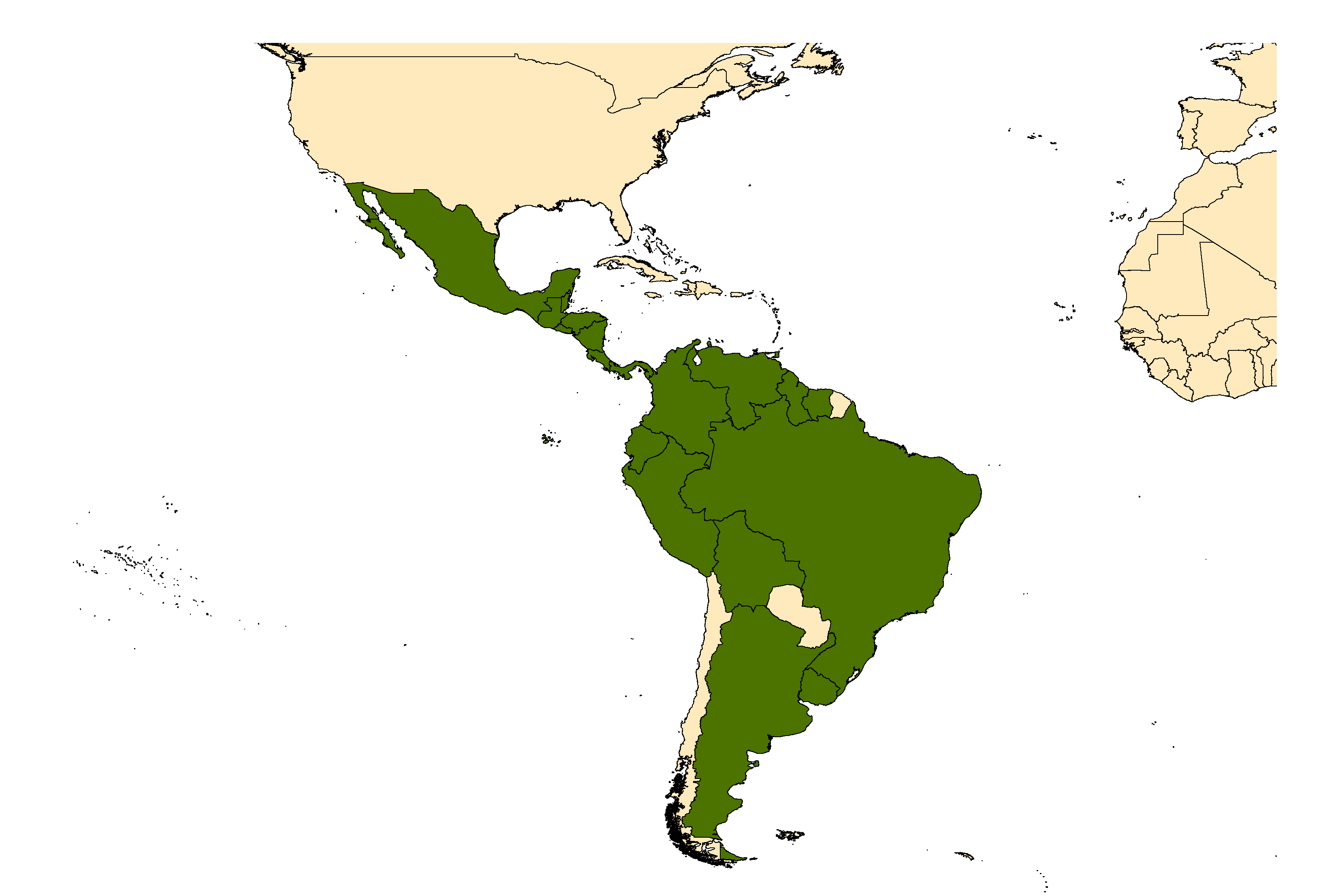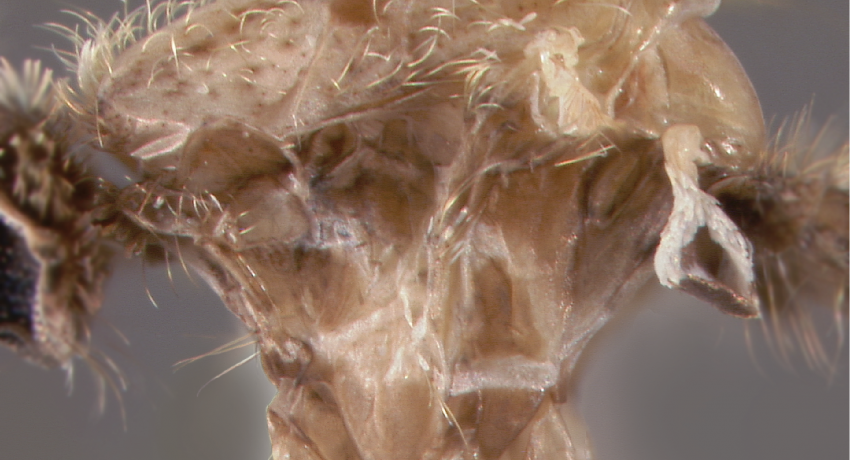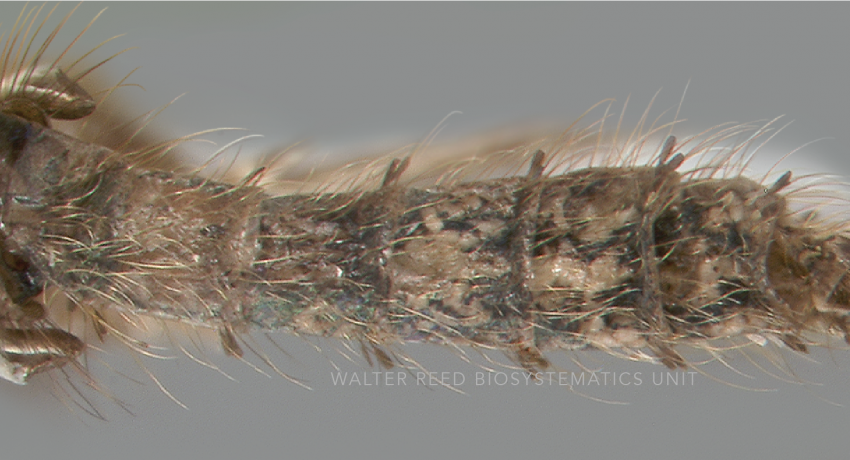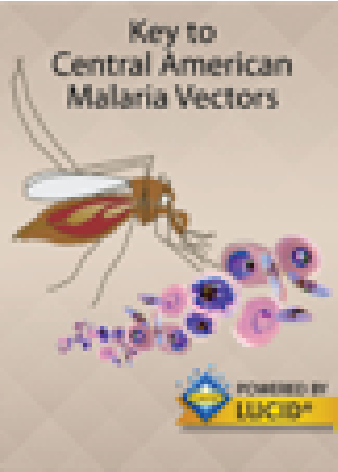NEOTROPICAL REGION
Etymology: not stated [spotted (L)]
Anopheles punctimacula is one of 24 unplaced species within the Arribalzagia Series, Laticorn Section of the Anopheles subgenus Anopheles. The species has two synonyms—strigimacula Dyar & Knab described from Mexico, and venezuelae Evans from Venezuela. Anopheles punctimacula is often confused with the morphologically similar taxa An. calderoni Wilkerson, An. malefactor Dyar & Knab and An. guarao Anduze & Capdevielle. Recently, An. malefactor was elevated from synonymy with An. punctimacula, and additional cryptic taxa have since been discovered, closely-related to An. malefactor and to An. calderoni, suggesting that the taxonomy of these Neotropical Arribalzagia species are far from resolved. In An. punctimacula populations collected in Panama and Costa Rica, six independently evolving molecular lineages were determined using nuclear rDNA and mtDNA COI gene sequences.
Type locality: Colon, Canal Zone, Panama
Type depository: U.S. National Museum, Washington, D.C., United States (USNM)
DIAGNOSTIC CHARACTERS (Click photos to view; mouse over and click large photo to zoom in.)
ADULT (illustrated): Thorax: Upper mesepimeron without pale scales. Abdomen: Abdominal segments with erect or semi-erect posterolateral scale tufts. Wing: Costal vein with a small subcostal dark spot at junction with subcostal vein; postsubcostal pale spot on the costal vein contiguous with the corresponding spot on vein R1; sector pale spot interrupted by accessory sector dark spot. Legs: Fe and Ti speckled with abundant large pale spots; Ta-III5 usually with a dark band or spot.
LARVA: Head: Seta 2-A truncate; seta 3-C 3-8 branched; seta 4-A long with lateral branches. Thorax: Seta 1-P branched; setae 9–12-P single. Abdominal segments: Seta 1 palmate with leaflets notched or distinctly serrate, more developed in segments III-VII. Terminal segments: Seta 1-X not inserted on the saddle, sometimes in a notch on the margin of the saddle; tergal plates 3.0 x wider than long.
TAXONOMIC KEYS
Komp 1942
Pelaez 1945
Causey et al. 1946
Deane, L.M. et al. 1946
Deane, M.P. et al. 1946
Becker et al. 2010
Beltrán-Aguilar et al. 2011
Sallum, et al. 2020
![]()
Anopheles – Central America - Adult
![]()
Anopheles – Central America - Larva
![]()
WRBU - Genera - Global - Adult
![]()
WRBU - Genera - Global - Larva
![]()
WRBU - Genera - Neotropical - Adult
![]()
WRBU - Genera - Neotropical - Larva
Exemplar DNA sequences
An. punctimacula s.s. COI (Panama HQ622626); An. malefactor COI (Panama HQ622625); An. calderoni COI (Colombia HQ642964-70, Ecuador HQ642971-74); ITS2: (HQ622618-HQ622622).
BIONOMICS
Immatures
Preferred immatures sites of Anopheles punctimacula s.l. immatures are often found amongst vegetation along the partially or completely shaded margins of clear water streams or swamps. In Ecuador, An. punctimacula s.l. immatures were positively associated with high levels of dissolved oxygen in the larval habitats.
Adults
In Panama, An. punctimacula s.s. is associated with jungle habitats and reportedly fly long distances in search of suitable hosts. Although it has been found naturally infected with Plasmodium parasites in Panama, An. punctimacula s.s. is not considered a primary vector. However, at high altitudes in Ecuador, Peru and southwestern Colombia, female Anopheles punctimacula s.l. is regarded as a primary malaria vector—females are highly attracted to humans and can be found in high numbers, feeding and resting in houses. Anopheles punctimacula s.l. are known also to feed on livestock and can be easily collected in light traps.
DISTRIBUTION NOTES
Argentina, Belize, Bolivia, Brazil, Colombia, Costa Rica, Ecuador, El Salvador, Guatemala, Guyana, Honduras, Mexico, Nicaragua, Panama, Peru, Uruguay, Venezuela.

WRBU VECTOR HAZARD REPORTS
View other WRBU Vector Hazard Reports
Available GIS Models:
An_punctimacula_Nyari_1 South and Central America
IMPORTANT REFERENCES (full citations below)
Dyar & Knab, 1906a: 136 (A)
Davis 1926 (F*)
Senevet 1934: 36 (P*)
Simmons 1937: 191 (F*)
Kumm 1941: 91 (E*)
Komp 1942 (M*, F*, P*, L*; keys)
Ross & Roberts 1943a: 25 (M*, F*, L*)
Pelaez 1945: 74 (F*; key)
Deane, L.M. et al. 1946 (F*, key, bionomics; NE Brazil & Amazonas)
Causey et al. 1946 (M*, key; NE Brazil & Amazonas)
Deane, M.P. et al. 1946 (L*, key, bionomics; NE Brazil & Amazonas)
Kreutzer et al. 1969 (chromosomes*)
Panday 1975a,b (distribution; Suriname)
Wilkerson & Strickman 1990: 7 (F*; distribution; Central America)
Wilkerson 1990 (M*, F*, P*, L*; taxonomy)
Rejmankova et al. 1998 (bionomics)
Rodríguez et al. 2002: 1 (E*)
Rossi & Martínez 2003: 471 (distribution; Uruguay)
Becker et al. 2010: 375 (F*, L*; key, taxonomy, distribution, bionomics)
Beltrán-Aguilar et al. 2011: 682 (M*, F*, P*, L*; taxonomy, keys, distribution)
Pinault & Hunter 2012 (bionomics)
Linton et al. 2013 (distribution; Ecuador)
Loaiza et al. 2013 (molecular taxonomy)
Berti et al. 2015 (distribution; Venezuela)
Bourke et al. 2018 (molecular taxonomy; as sensu lato)
Sallum, et al. 2020 (keys F, M, L)
CURRENT SYNONYMS
syn. strigimacula Dyar & Knab
1906a: 136 (A). Type locality: Cordoba, [Veracruz], Mexico (USNM).
syn. venezuelae Evans
1922: 214 (F*). Type locality: La Cabrera, Carabobo, Venezuela (NHMUK). References: Belkin 1968b: 11 (taxonomy); Wilkerson 1988 (taxonomy).
CITED REFERENCES
Becker, N., Petrić, D., Zgomba, M., Boase, C., Madon, M., Dahl, C., & Kaiser, A. (2010). Mosquitoes and their control (Second ed.). Berlin Heidelberg: Springer-Verlag.
Belkin, J.N. (1968b). Mosquito studies (Diptera, Culicidae). IX. The type specimens of New World mosquitoes in European museums. Contributions of the American Entomological Institute, 3(4), 1–69.
Beltrán-Aguilar, A., Ibañez-Bernal, S., Mendoza-Palmero, F., Sandoval-Ruiz, C.A., & Hernández-Xoliot, R.A. (2011). Taxonomy and distribution of the anopheline mosquitoes in the state of Veracruz, Mexico (Diptera: Culicidae, Anophelinae). Acta Zoologica Mexicana Nueva Serie, 27(3), 601–755.
Berti, J., Guzmán, H., Estrada, Y., & Ramírez, R. (2015). New records of mosquitoes (Diptera: Culicidae) from Bolívar State in South Eastern Venezuela, with 27 new species for the state and 5 of them new in the country. Frontiers in Public Health, 2, 10.
Causey, O.R., Deane, L.M., & Deane, M.P. (1946). An illustrated key by male genitalic characteristics for the identification of thirty-four species of Anophelini from the northeast and Amazon regions of Brazil, with a note on dissection technique. American Journal of Hygiene Monograph Series, 18, 21–31.
Davis, N.C. (1926). Notes on the female hypopygia of anopheline mosquitoes, with special reference to some Brazilian species. American Journal of Hygiene, 6, 1–22.
Deane, L.M., Causey, O.R., & Deane, M.P. (1946). I. An illustrated key by adult female characteristics for the identification of thirty-five species of Anophelini, with notes on the malaria vectors (Diptera, Culicidae). In Studies on Brazilian anophelines from the northeast and Amazon regions (pp. 1–18). Baltimore: The Johns Hopkins Press.
Deane, M.P., Causey, O. R., & Deane, L.M. (1946). III. An illustrated key by larval characteristics for the identification of thirty-two species of Anophelini, with descriptions of two larvae. In Studies on Brazilian anophelines from the northeast and Amazon regions (pp. 33–50). Baltimore: The Johns Hopkins Press.
Dyar, H.G., & Knab, F. (1906a). Diagnoses of new species of mosquitoes. Proceedings of the Biological Society of Washington, 19, 133–142.
Evans, A.M. (1922). Notes on Culicidae in Venezuela, with descriptions of new species. Part II. Annals of Tropical Medicine and Parasitology, 16, 213–222.
Komp, W.H.W. (1942). The anopheline mosquitoes of the Caribbean Region. National Institute of Health Bulletin No. 179.
Kreutzer, R.D., Tadano, T., Narang, S.L., & Kitzmiller, J.B. (1969). The salivary gland chromosomes of Anopheles punctimacula. Revista Brasileira de Malariologia y Doencas Tropicais, 21(3), 559–570.
Kumm, H.W. (1941). The eggs of some Costa Rican anophelines. American Journal of Tropical Medicine and Hygiene, 21, 91–102.
Linton, Y.-M., Pecor, J.E., Porter, C.H., Mitchell, L.B., Garzon-Moreno, A., Foley, D H., . . . Wilkerson, R.C. (2013). Mosquitoes of eastern Amazonian Ecuador: biodiversity, bionomics and barcodes. Memórias do Instituto Oswaldo Cruz, 108 (Supplement 1), 100–109.
Loaiza, J.R., Scott, M.E., Bermingham, E., Sanjur, O.I., Rovira, J.R., Dutari, L.C., . . . Conn, J.E. (2013). Novel genetic diversity within Anopheles punctimacula s.l.: Phylogenetic discrepancy between the barcode cytochrome c oxidase I (COI) gene and the rDNA second internal transcribed spacer (ITS2). Acta Tropica, 128(1), 61–69.
Panday, R.S. (1975a). Mosquito identification studies in a savanna forest in Surinam. Mosquito News, 35(2), 141–146.
Panday, R.S. (1975b). Mosquito identification studies in a typical coastal area in northern Surinam. Mosquito News, 35(3), 297–301.
Pelaez, D. (1945). Anofelinos de México. Clave para la determinación de especies y subespecies basada en los caracteres de las hembras adultas. Ciencia, 6, 69–77.
Pinault. L.L. & Hunter, F.F. (2012). Characterization of larval habitats of Anopheles albimanus, Anopheles pseudopunctipennis, Anopheles punctimacula, and Anopheles oswaldoi s.l. populations in lowland and highland Ecuador. Journal of Vector Ecology 37(1): 124-136.
Rejmankova, E., Pope, K.O., Roberts, D.R., Lege, M.G., Andre, R., Greico, J., & Alonzo, Y. (1998). Characterization and detection of Anopheles vestitipennis and Anopheles punctimacula (Diptera: Culicidae) larval habitats in Belize with field survey and SPOT satellite imagery. Journal of Vector Ecology, 23(1), 74–88.
Rodriguez, M. H., Chavez, B., Ulloa, A., & Arredondo-Jimenez., J. I. (2002). Fine structure of the eggs of Anopheles (Anopheles) punctimacula. Journal of the American Mosquito Control Association, 18(1), 1–9.
Ross, E.S., & Roberts, H.R. (1943a). Mosquito atlas. Part I. The Nearctic Anopheles, important malaria vectors of the Americas, and Aedes aegypti, Culex quinquefasciatus. Contributions of the American Entomological Institute.
Rossi, G.C., & Martinez, M. (2003). Mosquitoes (Diptera: Culicidae) from Uruguay. Entomon Vect, 10(4), 469–478.
Sallum, M.A.M., Obando, R.G., Carrejo, N. et al. Identification key to the Anopheles mosquitoes of South America (Diptera: Culicidae). Parasites and Vectors, 13, 542 (2020). https://www.biomedcentral.com/collections/id-keys-anopheles
Senevet, G. (1934). Contribution a l'étude des nymphes d'anophelines (4e Memoire). Archives de l'Institut Pasteur d'Algérie, 12, 29–76.
Simmons, J.S. (1937). Observations on the importance of Anopheles punctimacula as a malaria vector in Panama, and report of experimental infections in A. neomaculipalpus, A. apicimacula, and A. eiseni. American Journal of Tropical Medicine and Hygiene, 17, 191–212.
Wilkerson, R.C. (1988). Notes and redescriptions of some Anopheles (Series Arribalzagia) holotypes (Diptera, Culicidae) in the British Museum Natural History, UK. Proceedings of the Entomological Society of Washington, 90(4), 411–421.
Wilkerson, R.C. (1990). Redescriptions of Anopheles punctimacula and An. malefactor (Diptera: Culicidae). Journal of Medical Entomology, 27, 225–247.
Wilkerson, R.C., & Strickman, D. (1990). Illustrated key to the female anopheline mosquitoes of Central America and Mexico. Journal of the American Mosquito Control Association, 6, 7–34.
CITE THIS PAGE
Walter Reed Biosystematics Unit (Year). Anopheles punctimacula species page. Walter Reed Biosystematics Unit Website, http://wrbu.si.edu/vectorspecies/mosquitoes/puntimacula, accessed on [date (e.g. 03 February 2020) when you last viewed the site].











































































































































































